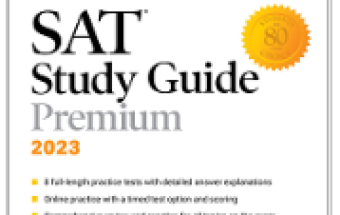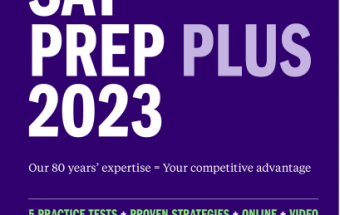SAT® Total Prep 2023 - Writing and Language Test
Questions 1–11 are based on the following passage and supplementary material.
The UN: Promoting World Peace
The United Nations (UN) is perhaps the most important political contribution of the 20th century. Some may argue that the work of the UN 1 ; an international peacekeeping organization—has proven futile, given persisting global conflict. But the UN’s worldwide influence demands a closer look. This organization’s global impact is undeniable. The UN is a strong political organization determined to create opportunities for its member nations to enjoy a peaceful and productive world. 2
3 Decades ago, provoked by the events of World Wars I and II, world leaders began imagining a politically neutral force for international peace. The UN was born in 1945 with 51 participating nations. It was to be a collective political authority for global peace and security. Today, 193 nations are UN members. 4 In keeping with the original hope, the UN still strives toward peaceful international relations.
Understandably, no single organization can perfectly solve the world’s countless, complex problems. But the UN has offered consistent relief for many of the past half-century’s most difficult disasters and conflicts. It also provides a safe space for international conversation. Moreover, it advocates for issues such as justice, trade, hunger relief, human rights, health, and gender 5 equality, the UN also coordinates care for those displaced by disaster and conflict, 6 dictates environmental protection, and works toward conflict reconciliation.
7 The UN’s budget, goals, and personnel count have significantly expanded with time to meet more needs. 8 The year 2014 witnessed the UN peacekeeping force grow to over 100,000 strong. These uniformed, volunteer, civilian personnel represent 128 nations. The UN’s budget has also grown over the years to support an international court system, as well as countless agencies,
committees, and centers addressing sociopolitical topics. Today’s UN undertakes important work, and it functions with remarkable organization and efficiency. Critics highlight shortcomings to discount the UN’s effectiveness. But considering the countless disasters to which the UN has responded over its six decades of existence, today’s world might enjoy 9 far less peace, freedom, and safety without the UN.
[1] From promoting overarching sociopolitical change to offering food and care for displaced groups, the UN serves to protect human rights. [2] Equally 10 quotable are its initiatives to foster international collaboration, justice, and peace. [3] The UN provided aid to the Philippines after the disastrous 2013 typhoon. [4] Certainly, this work is not finished. [5] But no other organization’s scope of work compares with the influence of the UN. [6] This brave endeavor to insist on and strive for peace, whatever the obstacles, has indeed united hundreds of once-divided nations. [7] Today, with eleven Nobel Peace Prizes to its name, the UN is undoubtedly an irreplaceable and profoundly successful force for peace. 11

1.
A) NO CHANGE
B) —an international peacekeeping organization;
C) —an international peacekeeping organization—
D) ; an international peacekeeping organization,
2. Which choice would most clearly end the paragraph with a restatement of the author’s claim?
A) The UN is an organization dedicated to advancing social and political justice around the world.
B) Those who argue otherwise are not well educated about geopolitical issues in the 20th century or today.
C) The UN has had its share of corruption over the years, but it has a well-earned reputation of effectively settling international disputes.
D) A better understanding of the UN suggests that the UN enables far greater peace in today’s world than could have been possible otherwise.
3.
A) NO CHANGE
B) Recently,
C) Consequently,
D) In other words,
4.
A) NO CHANGE
B) In having kept with the original hope, the UN still strives toward peaceful international relations.
C) In keeping with the original hope, the UN still strived toward peaceful international relations.
D) In keeping with the original hope, the UN still strove toward peaceful international relations.
5.
A) NO CHANGE
B) equality. The UN
C) equality: the UN
D) equality, The UN
6.
A) NO CHANGE
B) prefers
C) promotes
D) celebrates
7. Which choice provides the most logical introduction to the paragraph?
A) NO CHANGE
B) The UN has developed over the years, but critics charge it has met with limited success.
C) The responsibilities of the UN have expanded in recent years in response to challenging events.
D) The UN has maintained a quiet but effective voice on the world stage in spite of criticism.
8. Which choice best completes the sentence with accurate data based on the graphic?
A) NO CHANGE
B) The year 2010 led to an increase of approximately 100,000 in the UN peacekeeping force.
C) The year 2010 saw the UN peacekeeping force grow to approximately 100,000 strong.
D) The year 2010 saw the UN peacekeeping force decrease to just over 100,000 strong.
9.
A) NO CHANGE
B) considerably less peace, less freedom, and less safety
C) much less peace, less freedom, and less safety
D) significantly less peace and freedom, and less safety
10.
A) NO CHANGE
B) luminous
C) noteworthy
D) repeatable
11. Which sentence should be removed to improve the focus of the
concluding paragraph?
A) Sentence 1
B) Sentence 3
C) Sentence 5
D) Sentence 6
Questions 12–22 are based on the following passage.
DNA Analysis in a Day
Jane Saunders, a forensic DNA specialist, arrives at work and finds a request waiting for her: She needs to determine if the DNA of a fingernail with a few skin cells on it 12 match any records in the criminal database.
“Human DNA is a long, double-stranded 13 molecule; each strand consists of a complementary set of nucleotides,” she explains. “DNA has four nucleotides: 14 adenine (A), thymine (T), guanine (G), and, cytosine (C). On each strand is a sequence of nucleotides that ‘match,’ or pair up with the nucleotides on the other, or complementary, strand. 15 On the other hand, when there is an adenine on one strand, there is a thymine on the complementary strand, and where there is guanine on one strand, there is cytosine on the complementary strand.”
She begins by 16 moving the DNA from the rest of the sample,mtransferring it to a 17 reaction tube. She adds a solution of primers, DNA polymerase, and nucleotides. Her goal is to separate the two strands of the DNA molecules and then make complementary copiesof each strand.
18 The process of testing the DNA includes several steps and many changes in temperature. After mixing the primers, DNA
polymerase, and nucleotides with the evidence DNA, Saunders closes the reaction tube and puts it in a thermocycler. It is
programmed to raise the temperature to 94°C to separate the double strands into single strands, and then lower the temperature to 59°C to attach the primers to the single strands. Finally, it raises the temperature to 72°C for the DNA polymerase to build the
complementary strands. The thermocycler holds each temperature for one minute and repeats the cycle of three temperatures for at
least 30 cycles. At the end of each cycle, the number of DNA segments containing the sequence marked by the primers doubles. If
the original sample contains only 100 DNA strands, 19 the absolute final sample will have billions of segments.
[1] After a short lunch break, Saunders needs to separate and identify the copied DNA segments. [2] She had used primers that
bind to 13 specific sites in human DNA called short tandem repeats, or STRs. [3] The 13 STRs are segments of four nucleotides that repeat, such as GATAGATAGATA. [4] “Now here’s where the real magic happens!” Saunders says excitedly. [5] “Most DNA is identical for all humans. [6] But STRs vary greatly. [7] The chances of any two humans—other than identical twins—having the same set of 13 STRs is less than one in one trillion.” 20
Saunders knows that the detectives will be 21 prepared to hear her findings, so she sits down at her desk to compare her results with the criminal database in the hopes of finding a match. 22 Is it possible that too much time is spent identifying DNA in cases that are relatively easy to solve?
12.
A) NO CHANGE
B) matches
C) has matched
D) will be matching
13.
A) NO CHANGE
B) molecule, each strand consists
C) molecule each strand consists
D) molecule but each strand consists
14.
A) NO CHANGE
B) adenine (A), thymine (T), guanine (G), and cytosine (C).
C) adenine (A), thymine (T) guanine (G) and cytosine (C).
D) adenine (A) thymine (T), guanine (G) and cytosine (C).
15.
A) NO CHANGE
B) Specifically,
C) However,
D) Similarly,
16.
A) NO CHANGE
B) reviewing
C) changing
D) detaching
17. Which choice most effectively combines the sentences at the
underlined portion?
A) reaction tube since she adds
B) reaction tube, however, she adds
C) reaction tube, and adding
D) reaction tube, she adds
18. Which sentence most effectively establishes the central idea?
A) NO CHANGE
B) The object of testing the DNA is to re-create many strands of the DNA in question.
C) Saunders uses a variety of machines in order to analyze the DNA.
D) Saunders would be unable to identify the DNA without the thermocycler.
19.
A) NO CHANGE
B) absolutely the final sample
C) the final sample
D) the most final sample
20. Where should sentence 1 be placed to make the paragraph feel cohesive?
A) Where it is now
B) After sentence 2
C) After sentence 3
D) After sentence 4
21.
A) NO CHANGE
B) eager
C) impatient
D) conditioned
22. At this point, the writer wants to add a conclusion that best reflects Jane’s feelings conveyed in the passage. Which choice accomplishes that?
A) NO CHANGE
B) It takes a good deal of work and expense to identifyDNA in the world of modern forensics.
C) She takes pride in the fact that her scientific expertise plays such a key role in bringing criminals to justice.
D) She marvels at how far science has come in DNA analysis.
Questions 23–33 are based on the following passage.
Will Your Start-Up Succeed?
According to research from Harvard Business School, the majority of small businesses 23 fail in fact the success rate for a first-time company owner is a meager 18 percent. With odds so dismal, why would anyone become a business entrepreneur?
24 Veteran entrepreneurs achieve a higher 30 percent success rate, so the most predictive factor for success appears to be the number of innovations that a person has “pushed out.” More specifically, the people who succeed at building a robust start-up are the ones who have previously tried. Finally, many entrepreneurs 25 grab the idea for their business by solving practical problems, and it’s more than luck; 320 new entrepreneurs out of 100,000 do succeed by starting a company at the right time in the right industry.
Mitch Gomez is evidence of this data. He 26 did graduate from college with a degree in accounting. “I quickly realized that I have too big of a personality to be content practicing accounting,” he laughs.
He first built a successful insurance claims 27 service, and next founded his own independent insurance agency. “I continually employ my accounting skills, but I’ve ascertained that I’m an even more
effective salesperson.”
Similarly, Barbara Vital, the woman behind Vital Studio, explains, “I love spending as much time with my family as possible.” Vital saw an opportunity to 28 launch a monogramming business when her two young sons started school, so she founded a company that offers monogrammed backpacks and water bottles for kids, as well as 29 totes, rain boots; and baseball caps for college students. What is the secret to Vital’s success? “I’m always learning how to incorporate social media and add functionality to my product website to keep customers happy,” she says.
Finally, Chris Roth is an entrepreneur who can step out of his comfort zone. Always seeking a new 30 challenge his company designed and manufactured technology to keep the nozzles of water misting systems clean. Roth has also established a corporate travel agency and a truck customization company, most recently claiming he has become an innovator who beat the odds by “striving to serve customers better than my competition.” 31 Large companies often employ corporate travel agencies to arrange travel for their employees and clients.
Gomez, Vital, and Roth 32 agrees that although being an entrepreneur can be a formidable challenge, exceptionally skillful entrepreneurs have important strategies for success, including stretching 33 his personal boundaries and recovering from failures. “And nothing beats being your own boss,” adds Gomez.
23.
A) NO CHANGE
B) fail, in fact,
C) fail; in fact,
D) fail: in fact
24. Which sentence most effectively establishes the central idea?
A) NO CHANGE
B) The Small Business Administration defines a small business as one with fewer than 500 employees and less than $7 million in sales annually.
C) Many small businesses fail because company founders are not realistic about the amount of time it takes for a company to become profitable.
D) Running a small business can take up a lot more time than punching a clock for someone else and might not be enjoyable for everyone.
25.
A) NO CHANGE
B) derive
C) achieve
D) grasp
26.
A) NO CHANGE
B) has graduated
C) graduated
D) would have graduated
27.
A) NO CHANGE
B) service. And next
C) service and next
D) service; and next
28.
A) NO CHANGE
B) present
C) propel
D) impact
29.
A) NO CHANGE
B) totes; rain boots; and
C) totes, rain boots, and,
D) totes, rain boots, and
30.
A) NO CHANGE
B) challenge: his company
C) challenge; his company
D) challenge, his company
31. Which sentence would best support the central idea?
A) NO CHANGE
B) Savvy entrepreneurs know which risks are worth taking and which risks can tank their business before their doors open.
C) Now Roth’s small business installs water misters on restaurant patios and even sets up misting stations at outdoor music festivals.
D) Many new small businesses fail because company founders fail to do market research and identify the needs of their community.
32.
A) NO CHANGE
B) agree
C) should agree
D) had agreed
33.
A) NO CHANGE
B) their
C) our
D) her
Questions 34–44 are based on the following passage and supplementary material.
Edgard Varèse’s Influence
Today’s music, from rock to jazz, has many 34 influences. Andperhaps none is as unique as the ideas from French composer Edgard Varèse. Called “the father of electronic music,” he approached compositions from a different thworks “orgeoretical perspective than classical composers such as Bartók and Debussy. He called his 35 anized sound”; they did not 36 endear melodies but waged assaults of percussion, piano, and human voices. He thought of sounds as having intelligence and treated music spatially, as “sound objects floating in spaace."
His unique vision can be credited to his education in science. Born in 1883 in France, Varèse was raised by a great-uncle and grandfather in the Burgundy region. He was interested in classical music and composed his first opera as a teenager. While the family lived 37 in Italy he studied engineering in Turin, where he learned math and science and was inspired by the work of the artist Leonardo da Vinci.
In 1903, he returned to France to study music at the ParisConservatory. There, he composed the radical percussion performance piece Ionisation, which featured cymbals, snares, bass drum, xylophone, and sirens wailing. Later compositions were scored for the theremin, a new electronic instrument controlled by 38 the player’s hands waving over its antennae, which sense their position. No composer had ever scored music for the theremin before.
In his thirties, Varèse moved to New York City, where he played piano in a café and conducted other composers’ works until his own compositions gained success. His piece Amériques was performed in Philadelphia in 1926. Varèse went on to travel to the western United States, where he recorded, lectured, and collaborated with other musicians. By the 1950s, he was using tape recordings in 39 contention with symphonic performance. His piece Déserts was aired on a radio program amid selections by Mozart and Tchaikovsky but was received by listeners with hostility. 40
Varèse’s ideas were more forward-thinking than could be realized.One of his most ambitious scores, called Espace, was a choral symphony with multilingual lyrics, which was to be sung simultaneously by choirs in Paris, Moscow, Peking, and New York. He wanted the timing to be orchestrated by radio, but radio technology did not support worldwide transmission. If only Varèse 41 had had the Internet!
Although many of 42 their written compositions were lost in a firein 1918, many modern musicians and composers have been influenced by Varèse, including Frank Zappa, John Luther Adams, and John Cage, who wrote that Varèse is “more relevant to present musical necessity than even the Viennese masters.” 43 Despite being less famous than Stravinsky or Shostakovich, his impact is undeniable. 44 Varèse’s love of science and mathematics is shown in his later compositions, but less so in his early works.

34.
A) NO CHANGE
B) influences, and perhaps none is as
C) influences, but perhaps none is as
D) influences. Or perhaps none is as
35.
A) NO CHANGE
B) works “organized sound”: They
C) works “organized sound”, they
D) works—“organized sound”—they
36.
A) NO CHANGE
B) amplify
C) deprive
D) employ
37.
A) NO CHANGE
B) in Italy, he studied engineering in Turin, where he
C) in Italy he studied engineering in Turin where he
D) in Italy, he studied engineering in Turin; where he
38.
A) NO CHANGEB) the players’ hands
C) the players hands
D) the player’s hands’
39. A) NO CHANGE
B) conjunction
C) appropriation
D) supplication
40. If added to the paragraph, which fact would best support the author’s claims?
A) The critical response to his 1926 performance in Philadelphia
B) The selections by Mozart and Tchaikovsky that were played on the radio
C) Which specific states he traveled to in the western United States
D) The cities in which the radio program was aired
41.
A) NO CHANGE
B) would have had
C) would have
D) have had
42.
A) NO CHANGE
B) its
C) our
D) his
43. Which choice most accurately and effectively represents the
information in the graph?
A) NO CHANGE
B) Despite having fewer surviving works than his contemporaries, his impact is undeniable.
C) Even though he wrote pieces using a wider range of instruments than other composers, his impact isundeniable.
D) Even though far fewer of his works are now performed compared with those of his contemporaries, his impact is undeniable.
44. Which sentence best summarizes the central idea?
A) NO CHANGE
B) In contrast with his newfound popularity, Varèse’s early works have long been ignored due to increasing criticalhostility.
C) Varèse and his innovative compositions became an inspiration for artists seeking to challenge traditionalmusical beliefs.
D) Though Varèse’s contemporary critics failed to call him a “Viennese master,” this distinction is changing.









